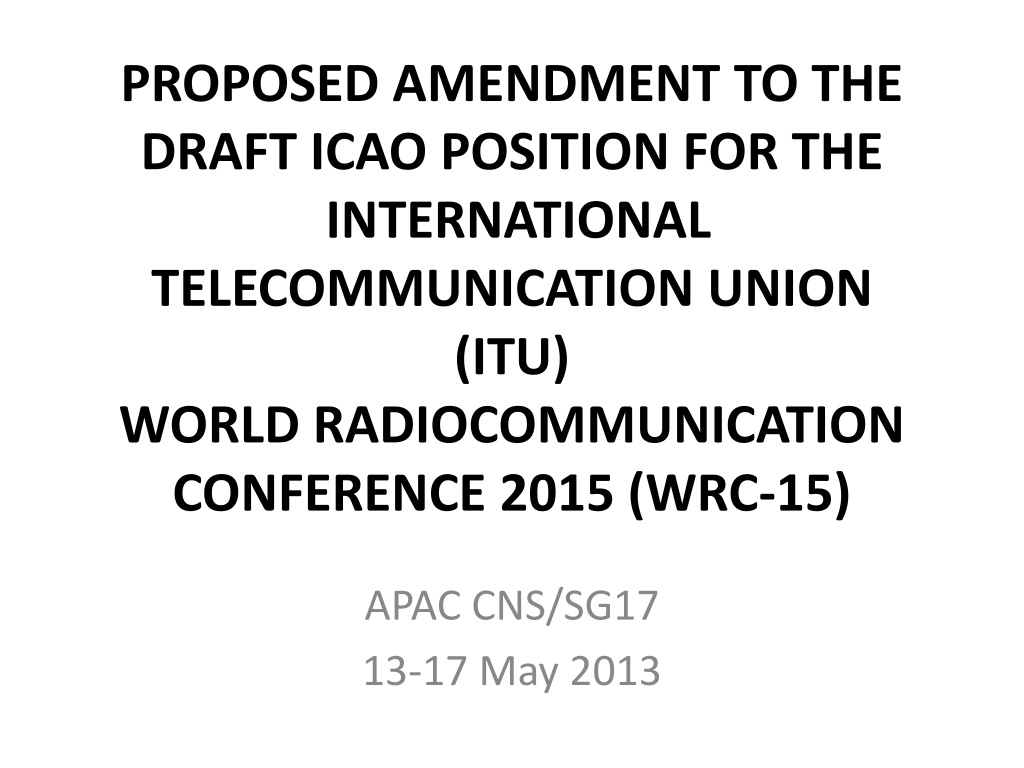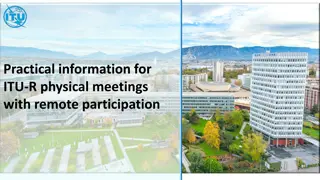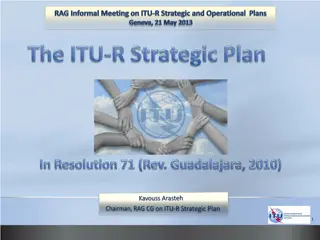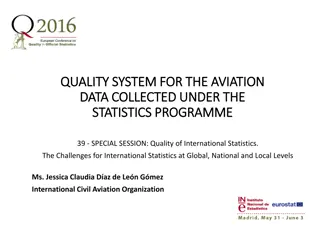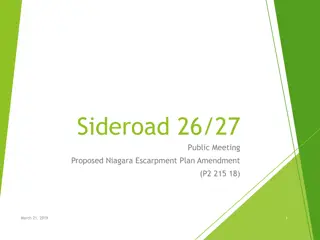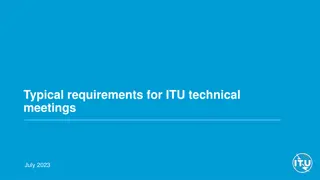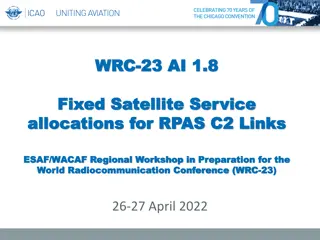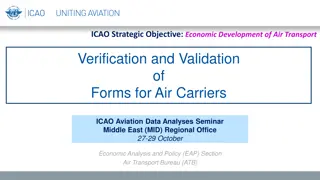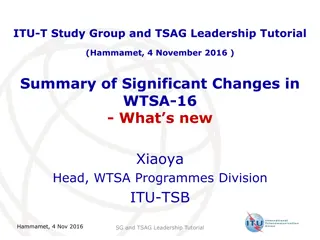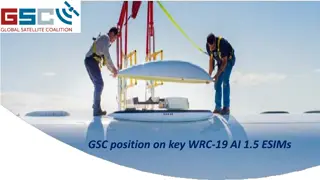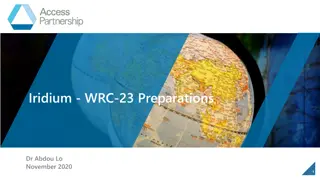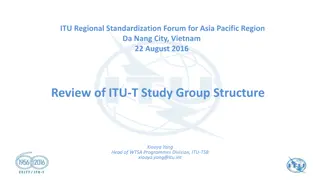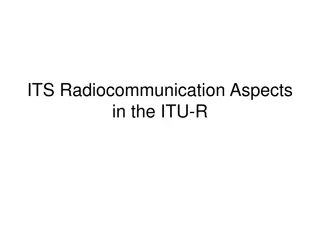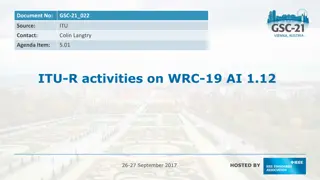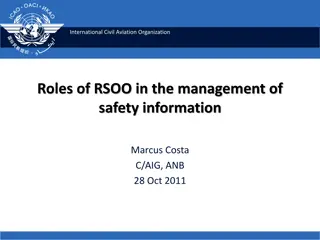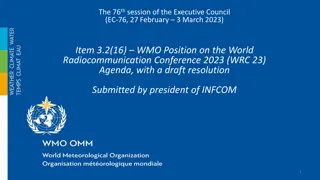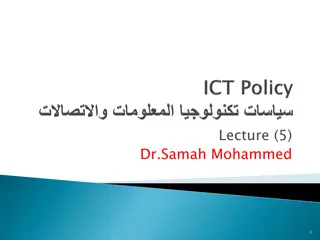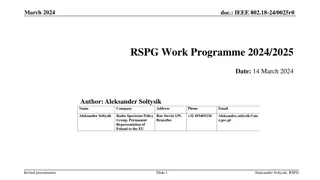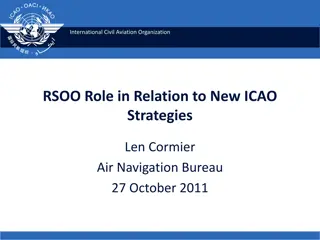Proposed Amendment to ICAO Position for ITU WRC-15
The proposed amendment to the draft ICAO position for the International Telecommunication Union (ITU) World Radiocommunication Conference 2015 emphasizes the importance of securing aviation interests in spectrum allocations and ensuring safety standards are not compromised.
Download Presentation

Please find below an Image/Link to download the presentation.
The content on the website is provided AS IS for your information and personal use only. It may not be sold, licensed, or shared on other websites without obtaining consent from the author. Download presentation by click this link. If you encounter any issues during the download, it is possible that the publisher has removed the file from their server.
E N D
Presentation Transcript
PROPOSED AMENDMENT TO THE DRAFT ICAO POSITION FOR THE INTERNATIONAL TELECOMMUNICATION UNION (ITU) WORLD RADIOCOMMUNICATION CONFERENCE 2015 (WRC-15) APAC CNS/SG17 13-17 May 2013
WORLD RADIOCOMMUNICATION CONFERENCE Next WRC Nov. 2015 ICAO privileged position at WRCs Position at WRCs reflects the coordinated requirements of the international civil aviation community
WRC 2015 ever-increasing competition even danger of loss of some of aviation s allocations within the limited available spectrum industry participation has almost doubled, but civil aviation representation has not been very encouraging An increased level of support by the aviation community is essential
APAC Member states States should commit to support ICAO position at WRC in regional and international activities conducted in the preparation for WRCs Work with national radio regulators to secure a national/APT position in line with that of ICAO; and Where possible actively participate in the preparation work at regional and global platforms such as APT-APG, ITU-R and other bodies include in their proposals to the WRC, to the extent possible material consistent with the ICAO position undertake to provide for aviation interests to be fully integrated into the States position for WRC
ICAO Positions principles Ensure that the ITU Radio Regulations do not compromise the safety of civil aviation ITU Radio Regulations shall not be in conflict with ICAO Standards and Recommended Practices Frequency allocations to aeronautical safety services shall be protected in conformity with internationally agreed requirements. Changes to frequency allocations need to be supported by adequate studies in the ITU-R Sector or in ICAO, as appropriate.
ICAOs position details (draft amendments, item per item) Refers to APAC CNS SG/17 WP15, Appendix C
400 6 000 MHz (1/2) Item 1.1 Industry seeks 500 MHz of additional spectrum available for international mobile telecommunications (IMT), ideally below 6 GHz ICAO: care needs to be taken not only with any proposal for co-frequency band sharing of aeronautical services with non-aeronautical services but also with proposals for the introduction of new allocations in adjacent frequency bands ICAO to oppose any new allocation to the mobile service in or adjacent to: - frequency bands allocated to aeronautical safety services (ARNS, AM(R)S, AMS(R)S); or - frequency bands used by fixed satellite service (FSS) systems for aeronautical purposes as part of the ground infrastructure for transmission of aeronautical and meteorological information or for AMS(R)S feeder links, unless it has been demonstrated through agreed studies that there will be no impact on aeronautical services
400 6 000 MHz (2/2) Protection of: Emergency Locator Transmitter: Emergency locator transmitters, for search and rescue operations. Distance measuring equipment (DME): Secondary surveillance radar (SSR): SSR is the ICAO standard system that operates on two frequencies (1 030 and 1 090 MHz), used to identify the position of an aircraft based on an aircrafts response to an interrogation by the ground based element of the SSR system. 1 090 Extended Squitter (1 090ES) Multilateration (MLAT): Airborne collision avoidance system (ACAS): Universal access transceiver (UAT): Aeronautical Communications Future Communication System: Primary radar: Global navigation satellite systems: Aeronautical mobile satellite communication systems: Approach primary radar: Fixed Satellite Service (FSS) systems used for aeronautical purposes: Radio altimeters: Microwave Landing System (MLS): UAS Terrestrial and UAS Satellite communications: AeroMACS: Aeronautical Telemetry: Airborne Weather Radar: Fixed Satellite Service (FSS) systems used for aeronautical purposes: VSAT networks for transmission (E-s) of critical aeronautical and meteorological information.
amateur service Item 1.4 To ensure that any allocation made to the amateur service shall not cause harmful interference to the operation of aeronautical systems operating under the allocation to the aeronautical mobile (R) service in the adjacent frequency band 5 450 5 480 kHz in Region 2.
Unmanned aircraft systems (UAS) Item 1.5 Unmanned aircraft systems (UAS) have great potential for innovative civil applications, provided that their operation does not introduce risks to the safety of life. Taking into account Recommendations 1/12 and 1/13 of the 12thAir Navigation Conference (November 2012) That ICAO develop and implement a comprehensive aviation frequency spectrum strategy which includes the following objectives: clearly state in the strategy the need for aeronautical systems to operate in spectrum allocated to an appropriate aeronautical safety service ; and That ICAO support studies in the International Telecommunication Union Radio Communication Sector (ITU-R) to determine what ITU regulatory actions are required to enable use of frequency bands allocated to the fixed satellite service for remotely piloted aircraft system command and control (C2) links to ensure consistency with ICAO technical and regulatory requirements for a safety service. : In order to support the use of FSS systems for UAS CNPC links in non-segregated airspace, the technical and regulatory actions identified by studies under Resolution 153 (WRC-12) must be consistent with the above Recommendations, and satisfy the following conditions: That the technical and regulatory actions should be limited to the case of UAS using satellites, as studied, and not set a precedent that puts other aeronautical safety services at risk. 1. That the technical and regulatory actions should be limited to the case of UAS using satellites, as studied, and not set a precedent that puts other aeronautical safety services at risk. 2. That all frequency bands which carry aeronautical safety communications need to be clearly identified in the Radio Regulations. 3. That the assignments and use of the relevant frequency bands have to be consistent with article 4.10 of the Radio Regulations which recognizes that safety services require special measures to ensure their freedom from harmful interference. 4. Knowledge that any assignment operating in those frequency bands: is in conformity with technical criteria of the Radio Regulations, has been successfully co-ordinated, including cases where co-ordination was not completed but the ITU examination of probability of harmful interference resulted in a favourable finding, under article 9 of the radio regulations (e.g.or any caveats placed on that assignment have been addressed and resolved) such that the assignment is able to satisfy the requirements to provide BLOS communications for UAS, and has been recorded in the International Master Frequency Register. 5. That all assignments used by satellite systems for the provision of UAS CNPC links are registered with favourable findings in the master international frequency register. 65. That interference to systems is reported in a transparent manner and addressed in the appropriate timescale. 76. That realistic worst case conditions, with the inclusion including of an appropriate safety margin can be applied during compatibility studies. 87 That any operational considerations for UAS will be handled in ICAO and not in the ITU.
fixed satellite service Item 1.6 To oppose any new fixed satellite service allocation unless it has been demonstrated through agreed studies that there will be no impact on aviation use of the relevant frequency band.
5091 5150 MHz Item 1.7 Support the removal of date limitations on the fixed satellite service (FSS) allocation in the frequency band 5091 5150 MHz subject to: the retention of the aeronautical protections contained in Resolution 114 (WRC-12). improving the flexibility for managing the allowed FSS satellite noise temperature increase by the aeronautical mobile (R) and aeronautical radionavigation services operating in the band 5 091-5 150 MHz.
24.25 24.65 GHz Item 1.10 To oppose any new mobile satellite service allocation unless it has been demonstrated through agreed studies that there will be no impact on aviation use in the 24.25 24.65 GHz frequency band in Regions 2 and 3.
8 750 8 850 MHz Item 1.11 To oppose any new allocation to the Earth exploration-satellite service allocation, unless it has been demonstrated through agreed studies that there will be no impact on aviation use in the frequency band 8 750 8 850 MHz.
9 000 9 200 MHz Item 1.12 Oppose any allocation to the Earth exploration- satellite service in the frequency band 9 000 9 200 MHz unless:- it has been demonstrated through agreed studies that there will be no impact on aviation use. no additional constraints are placed on the use of the frequency band by aeronautical systems No change to Nos. 5.337, 5.427, 5.474 and 5.475.
SAR frequencies protection Item 1.16 To ensure that any change to the regulatory provisions and spectrum allocations resulting from this agenda item do not adversely impact on the capability of search and rescue aircraft to effectively communicate with vessels during disaster relief operations.
WAIC systems Item 1.17 Support any necessary additional global aeronautical mobile (route) service allocation required to facilitate the implementation of WAIC, provided technical studies show that WAIC systems will not cause harmful interference to existing or planned aeronautical systems operating in frequency bands allocated to aeronautical safety services the aeronautical bands.
fixed-satellite service earth stations within the band 3 400 4 200 MHz Item 4 Consideration of technical and regulatory actions in order to support existing and future operation of fixed-satellite service earth stations within the band 3 400 4 200 MHz, as an aid to the safe operation of aircraft and reliable distribution of meteorological information in some countries in Region 1 Possibly extend to APAC region
406 406.1 MHz Item 9.1.1 Support any proposals for increased protection of COSPAS-SARSAT system in the frequency band 406 406.1 MHz.
definitions of fixed service, fixed station and mobile station Item 9.1.6 Ensure that any change to the definitions as a result of a review of the studies referenced in Resolution 957 do not adversely impact aviation.
Draft Conclusion 17/x Support for ICAO Position in WRC-15 That, States be urged to Work with national radio regulators to secure a national/APT position in line with that of ICAO; and Where possible actively participate in the preparation work at regional and global platforms such as APT-APG, ITU-R and other bodies.
